| 编辑推荐: |
| 本文来自于cnblogs,文章主要介绍了使用matplotlib绘制折线图、随机漫步以及Pygal模拟掷骰子等例子。 |
|
摘要:数据可视化主要旨在借助于图形化手段,清晰有效地传达与沟通信息。但是,这并不就意味着数据可视化就一定因为要实现其功能用途而令人感到枯燥乏味,或者是为了看上去绚丽多彩而显得极端复杂。为了有效地传达思想概念,美学形式与功能需要齐头并进,通过直观地传达关键的方面与特征,从而实现对于相当稀疏而又复杂的数据集的深入洞察。然而,设计人员往往并不能很好地把握设计与功能之间的平衡,从而创造出华而不实的数据可视化形式,无法达到其主要目的,也就是传达与沟通信息。数据可视化与信息图形、信息可视化、科学可视化以及统计图形密切相关。当前,在研究、教学和开发领域,数据可视化乃是一个极为活跃而又关键的方面。“数据可视化”这条术语实现了成熟的科学可视化领域与较年轻的信息可视化领域的统一
1 折线图的制作
1.1 需求描述
使用matplotlib绘制一个简单的折线图,在对其进行定制,以实现信息更加丰富的数据可视化,绘制(1,2,3,4,5)的平方折线图。
1.2 源码
#coding=utf-8
import matplotlib as mpl
import matplotlib.pyplot as plt
import pylab
# 解决中文乱码问题
mpl.rcParams['font.sans-serif']=['SimHei']
mpl.rcParams['axes.unicode_minus']=False
# squares = [1,35,43,3,56,7]
input_values = [1,2,3,4,5]
squares = [1,4,9,16,25]
# 设置折线粗细
plt.plot(input_values,squares,linewidth=5)
# 设置标题和坐标轴
plt.title('平方数图',fontsize=24)
plt.xlabel('值',fontsize=14)
plt.ylabel('平方值',fontsize=14)
# 设置刻度大小
plt.tick_params(axis='both',labelsize=14)
plt.show() |
1.3 生成结果
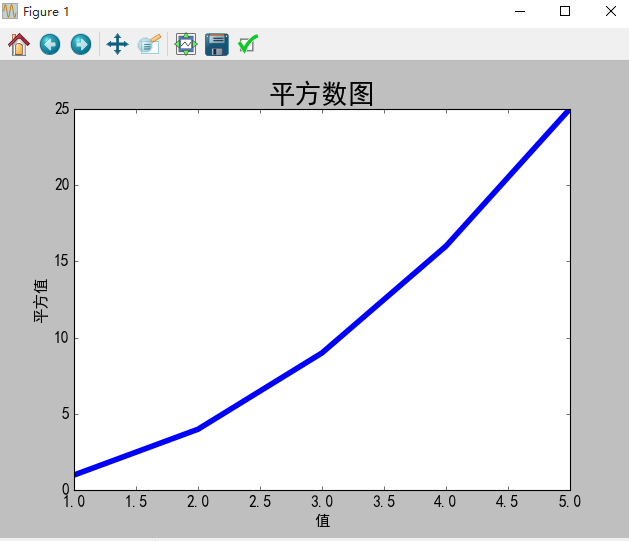
2 scatter()绘制散点图
2.1 需求描述
使用matplotlib绘制一个简单的散列点图,在对其进行定制,以实现信息更加丰富的数据可视化,绘制(1,2,3,4,5)的散点图。
2.2 源码
#coding=utf-8
import matplotlib as mpl
import matplotlib.pyplot as plt
import pylab
# 解决中文乱码问题
mpl.rcParams['font.sans-serif']=['SimHei']
mpl.rcParams['axes.unicode_minus']=False
# 设置散列点纵横坐标值
x_values = [1,2,3,4,5]
y_values = [1,4,9,16,25]
# s设置散列点的大小,edgecolor='none'为删除数据点的轮廓
plt.scatter(x_values,y_values,c='red',edgecolor='none',
s=40)
# 设置标题和坐标轴
plt.title('平方数图',fontsize=24)
plt.xlabel('值',fontsize=14)
plt.ylabel('平方值',fontsize=14)
# 设置刻度大小
plt.tick_params(axis='both',which='major',labelsize=14)
# 自动保存图表,参数2是剪裁掉多余空白区域
plt.savefig('squares_plot.png',bbox_inches='tight')
plt.show() |
2.3 生成结果
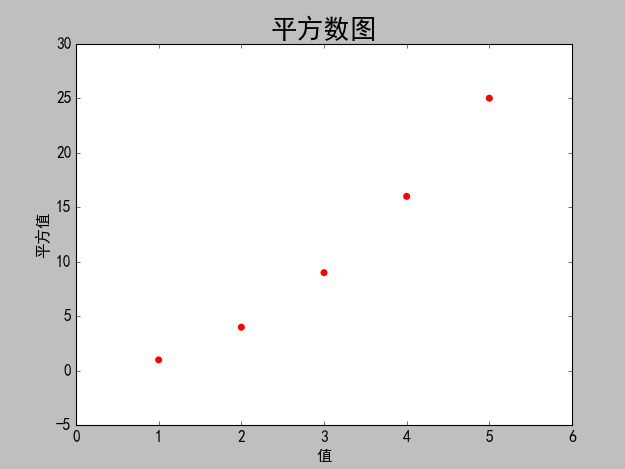
2.4 需求改进
使用matplotlib绘制一个简单的散列点图,在对其进行定制,以实现信息更加丰富的数据可视化,绘制1000个数的散点图。并自动统计数据的平方,自定义坐标轴
2.5 源码改进
#coding=utf-8
import matplotlib as mpl
import matplotlib.pyplot as plt
import pylab
# 解决中文乱码问题
mpl.rcParams['font.sans-serif']=['SimHei']
mpl.rcParams['axes.unicode_minus']=False
# 设置散列点纵横坐标值
# x_values = [1,2,3,4,5]
# y_values = [1,4,9,16,25]
# 自动计算数据
x_values = list(range(1,1001))
y_values = [x**2 for x in x_values]
# s设置散列点的大小,edgecolor='none'为删除数据点的轮廓
# plt.scatter(x_values,y_values,c='red',edgecolor='none',
s=40)
# 自定义颜色c=(0,0.8,0.8)红绿蓝
# plt.scatter(x_values,y_values,c=(0,0.8,0.8),
edgecolor='none',s=40)
# 设置颜色随y值变化而渐变
plt.scatter(x_values,y_values,c=y_values,cmap=plt.
cm.Reds,edgecolor='none',s=40)
# 设置标题和坐标轴
plt.title('平方数图',fontsize=24)
plt.xlabel('值',fontsize=14)
plt.ylabel('平方值',fontsize=14)
#设置坐标轴的取值范围
plt.axis([0,1100,0,1100000])
# 设置刻度大小
plt.tick_params(axis='both',which='major',labelsize=14)
# 自动保存图表,参数2是剪裁掉多余空白区域
plt.savefig('squares_plot.png',bbox_inches='tight')
plt.show() |
2.6 改进结果
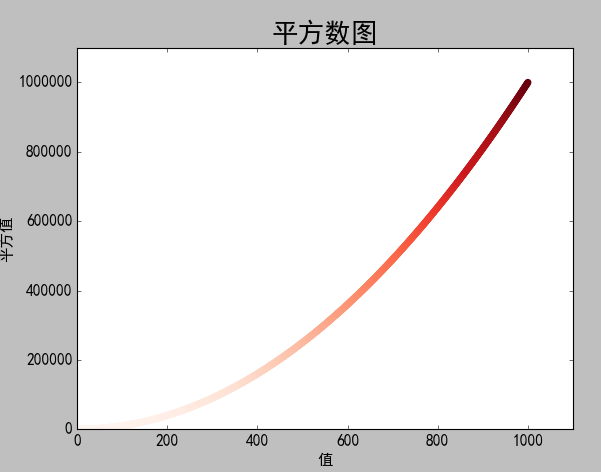
3 随机漫步图
3.1 需求描述
随机漫步是每次步行方向和步长都是随机的,没有明确的方向,结果由一系列随机决策决定的。本实例中random_walk决策步行的左右上下方向和步长的随机性,rw_visual是图形化展示。
3.2 源码
random_walk.py
from random
import choice
class RandomWalk():
'''一个生成随机漫步数据的类'''
def __init__(self,num_points=5000):
'''初始化随机漫步属性'''
self.num_points = num_points
self.x_values = [0]
self.y_values = [0]
def fill_walk(self):
'''计算随机漫步包含的所有点'''
while len(self.x_values)<self.num_points:
# 决定前进方向及沿着该方向前进的距离
x_direction = choice([1,-1])
x_distance = choice([0,1,2,3,4])
x_step = x_direction*x_distance
y_direction = choice([1,-1])
y_distance = choice([0,1,2,3,4])
y_step = y_direction*y_distance
# 拒绝原地踏步
if x_step == 0 and y_step == 0:
continue
# 计算下一个点的x和y
next_x = self.x_values[-1] + x_step
next_y = self.y_values[-1] + y_step
self.x_values.append(next_x)
self.y_values.append(next_y) |
rw_visual.py
#-*- coding:
utf-8 -*-
#coding=utf-8
import matplotlib as mpl
import matplotlib.pyplot as plt
import pylab
from random_walk import RandomWalk
# 解决中文乱码问题
mpl.rcParams['font.sans-serif']=['SimHei']
mpl.rcParams['axes.unicode_minus']=False
# 创建RandomWalk实例
rw = RandomWalk()
rw.fill_walk()
plt.figure(figsize=(10,6))
point_numbers = list(range(rw.num_points))
# 随着点数的增加渐变深红色
plt.scatter(rw.x_values,rw.y_values,c=point_numbers,
cmap=plt.cm.Reds,edgecolors='none',s=1)
# 设置起始点和终点颜色
plt.scatter(0,0,c='green',edgecolors='none',s=100)
plt.scatter(rw.x_values[-1],rw.y_values[-1],c='blue',
edgecolors='none',s=100)
# 设置标题和纵横坐标
plt.title('随机漫步图',fontsize=24)
plt.xlabel('左右步数',fontsize=14)
plt.ylabel('上下步数',fontsize=14)
# 隐藏坐标轴
plt.axes().get_xaxis().set_visible(False)
plt.axes().get_yaxis().set_visible(False)
plt.show() |
3.3 生成结果
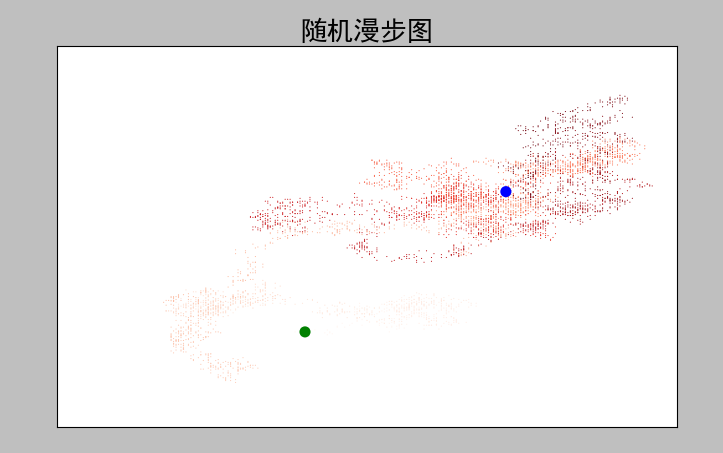
4 Pygal模拟掷骰子
4.1 需求描述
对掷骰子的结果进行分析,生成一个掷筛子的结果数据集并根据结果绘制出一个图形。
4.2 源码
Die类
import random
class Die:
"""
一个骰子类
"""
def __init__(self, num_sides=6):
self.num_sides = num_sides
def roll(self):
# 返回一个1和筛子面数之间的随机数
return random.randint(1, self.num_sides) |
die_visual.py
#coding=utf-8
from die import Die
import pygal
import matplotlib as mpl
# 解决中文乱码问题
mpl.rcParams['font.sans-serif']=['SimHei']
mpl.rcParams['axes.unicode_minus']=False
die1 = Die()
die2 = Die()
results = []
for roll_num in range(1000):
result =die1.roll()+die2.roll()
results.append(result)
# print(results)
# 分析结果
frequencies = []
max_result = die1.num_sides+die2.num_sides
for value in range(2,max_result+1):
frequency = results.count(value)
frequencies.append(frequency)
print(frequencies)
# 直方图
hist = pygal.Bar()
hist.title = '骰子投掷1000次各面结果统计图'
hist.x_labels =[x for x in range(2,max_result+1)]
hist.x_title ='结果'
hist.y_title = '结果分布'
hist.add('D6+D6',frequencies)
hist.render_to_file('die_visual.svg')
# hist.show() |
4.3 生成结果
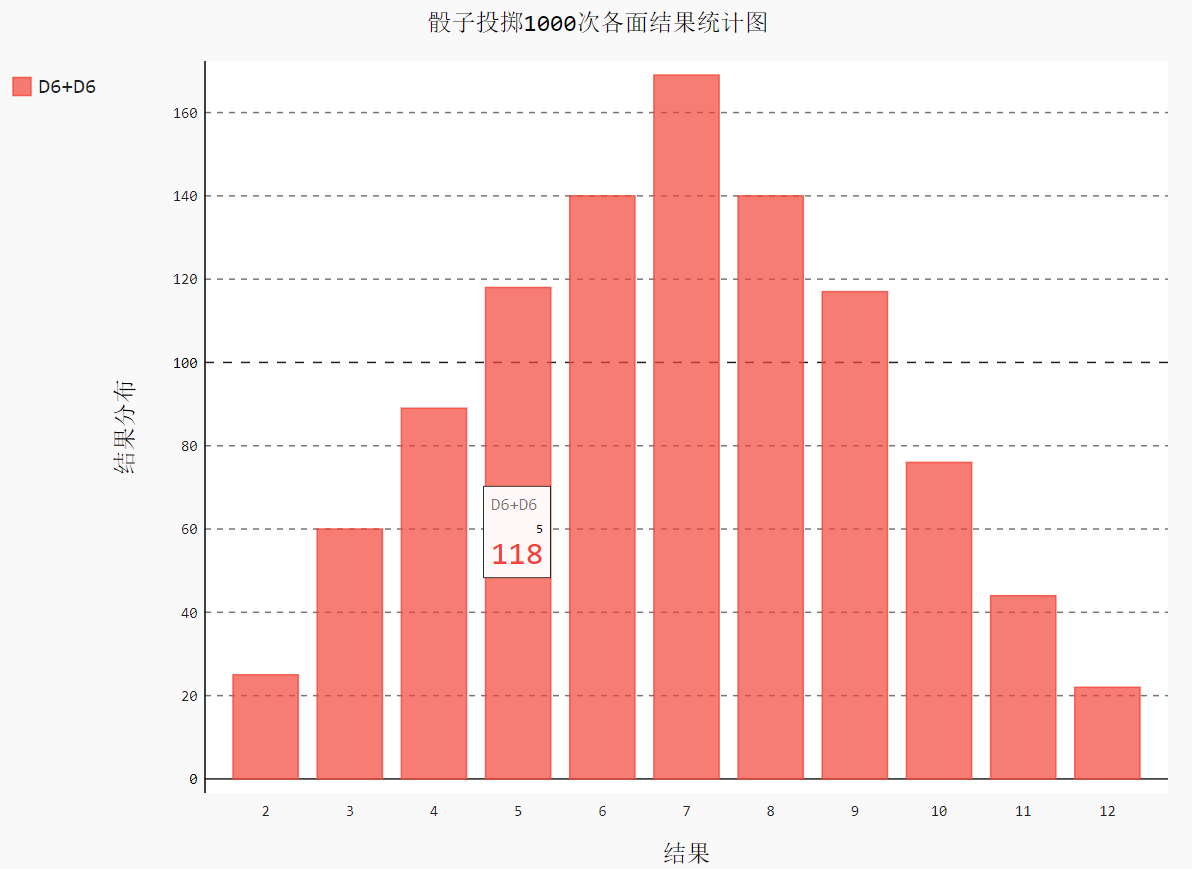
5 同时掷两个骰子
5.1 需求描述
对同时掷两个骰子的结果进行分析,生成一个掷筛子的结果数据集并根据结果绘制出一个图形。
5.2 源码
#conding=utf-8
from die import Die
import pygal
import matplotlib as mpl
# 解决中文乱码问题
mpl.rcParams['font.sans-serif']=['SimHei']
mpl.rcParams['axes.unicode_minus']=False
die1 = Die()
die2 = Die(10)
results = []
for roll_num in range(5000):
result = die1.roll() + die2.roll()
results.append(result)
# print(results)
# 分析结果
frequencies = []
max_result = die1.num_sides+die2.num_sides
for value in range(2,max_result+1):
frequency = results.count(value)
frequencies.append(frequency)
# print(frequencies)
hist = pygal.Bar()
hist.title = 'D6 和 D10 骰子5000次投掷的结果直方图'
# hist.x_labels=['2','3','4','5','6','7','8','9','10',
'11','12','13','14','15','16']
hist.x_labels=[x for x in range(2,max_result+1)]
hist.x_title = 'Result'
hist.y_title ='Frequency of Result'
hist.add('D6 + D10',frequencies)
hist.render_to_file('dice_visual.svg') |
5.3 生成结果
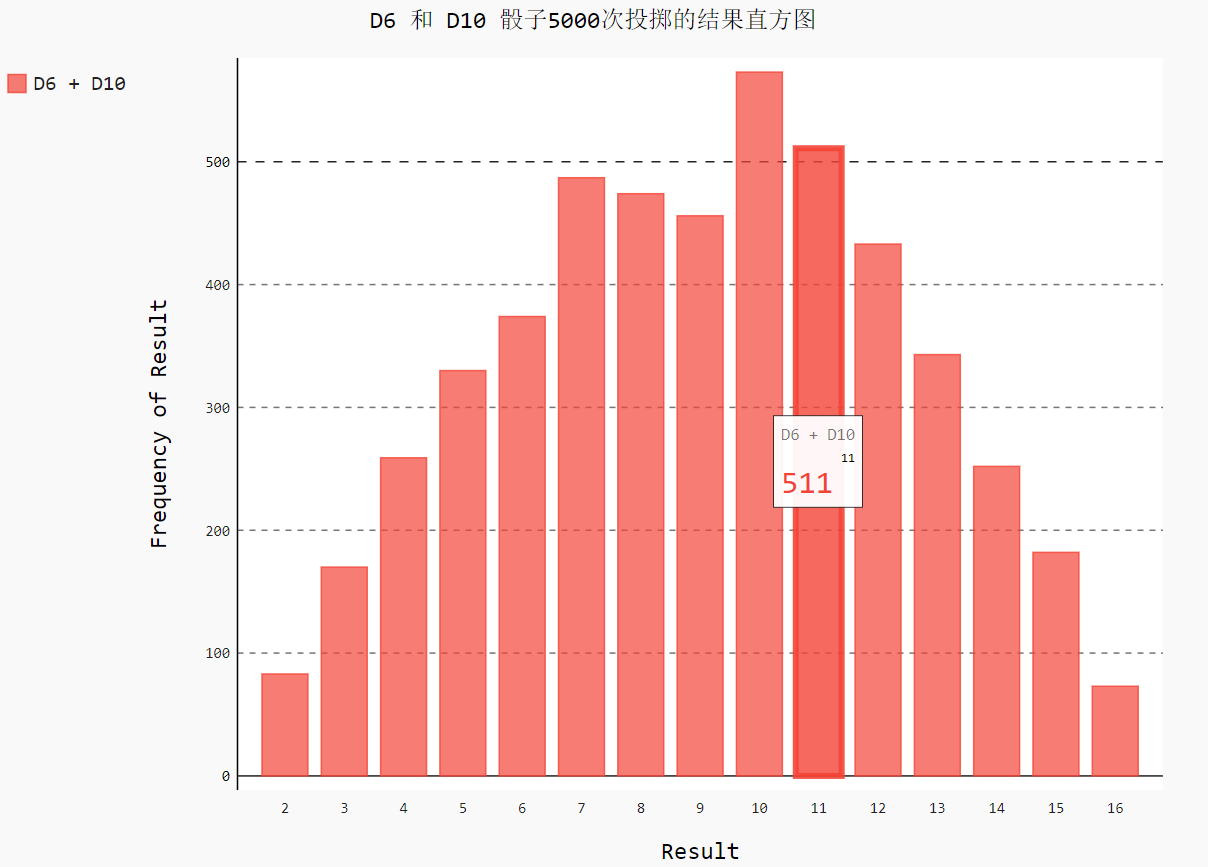
6 绘制气温图表
6.1 需求描述
对csv文件进行处理,提取并读取天气数据,绘制气温表,在图表中添加日期并绘制最高气温和最低气温的折线图,并对气温区域进行着色。
6.2 源码
csv文件中2014年7月部分数据信息
View Code
AKDT,Max TemperatureF,Mean
TemperatureF,
Min TemperatureF,Max Dew PointF,MeanDew
PointF,Min DewpointF,Max Humidity, Mean Humidity,
Min Humidity, Max Sea Level PressureIn,
Mean Sea
Level PressureIn, Min Sea Level PressureIn,
Max
VisibilityMiles, Mean VisibilityMiles, Min VisibilityMiles,
Max Wind SpeedMPH, Mean Wind SpeedMPH, Max Gust
SpeedMPH,PrecipitationIn, CloudCover, Events,
WindDirDegrees
2014-7-1,64,56,50,53,51,48,96,83,58,30.19,30.00,29.79,
10,10,10,7,4,,0.00,7,,337
2014-7-2,71,62,55,55,52,46,96,80,51,29.81,29.75,29.66,
10,9,2,13,5,,0.14,7,Rain,327
2014-7-3,64,58,53,55,53,51,97,85,72,29.88,29.86,29.81,
10,10,8,15,4,,0.01,6,,258
2014-7-4,59,56,52,52,51,50,96,88,75,29.91,29.89,29.87,
10,9,2,9,2,,0.07,7,Rain,255
2014-7-5,69,59,50,52,50,46,96,72,49,29.88,29.82,29.79,
10,10,10,13,5,,0.00,6,,110
2014-7-6,62,58,55,51,50,46,80,71,58,30.13,30.07,29.89,
10,10,10,20,10,29,0.00,6,Rain,213
2014-7-7,61,57,55,56,53,51,96,87,75,30.10,30.07,30.05,
10,9,4,16,4,25,0.14,8,Rain,211
2014-7-8,55,54,53,54,53,51,100,94,86,30.10,30.06,30.04,
10,6,2,12,5,23,0.84,8,Rain,159
2014-7-9,57,55,53,56,54,52,100,96,83,30.24,30.18,30.11,
10,7,2,9,5,,0.13,8,Rain,201
2014-7-10,61,56,53,53,52,51,100,90,75,30.23,30.17,30.03,
10,8,2,8,3,,0.03,8,Rain,215
2014-7-11,57,56,54,56,54,51,100,94,84,30.02,30.00,29.98,
10,5,2,12,5,,1.28,8,Rain,250
2014-7-12,59,56,55,58,56,55,100,97,93,30.18,30.06,29.99,
10,6,2,15,7,26,0.32,8,Rain,275
2014-7-13,57,56,55,58,56,55,100,98,94,30.25,30.22,30.18,
10,5,1,8,4,,0.29,8,Rain,291
2014-7-14,61,58,55,58,56,51,100,94,83,30.24,30.23,30.22,
10,7,0,16,4,,0.01,8,Fog,307
2014-7-15,64,58,55,53,51,48,93,78,64,30.27,30.25,30.24,
10,10,10,17,12,,0.00,6,,318
2014-7-16,61,56,52,51,49,47,89,76,64,30.27,30.23,30.16,
10,10,10,15,6,,0.00,6,,294
2014-7-17,59,55,51,52,50,48,93,84,75,30.16,30.04,29.82,
10,10,6,9,3,,0.11,7,Rain,232
2014-7-18,63,56,51,54,52,50,100,84,67,29.79,29.69,29.65
,10,10,7,10,5,,0.05,6,Rain,299
2014-7-19,60,57,54,55,53,51,97,88,75,29.91,29.82,29.68,
10,9,2,9,2,,0.00,8,,292
2014-7-20,57,55,52,54,52,50,94,89,77,29.92,29.87,29.78,
10,8,2,13,4,,0.31,8,Rain,155
2014-7-21,69,60,52,53,51,50,97,77,52,29.99,29.88,29.78,
10,10,10,13,4,,0.00,5,,297
2014-7-22,63,59,55,56,54,52,90,84,77,30.11,30.04,29.99,
10,10,10,9,3,,0.00,6,Rain,240
2014-7-23,62,58,55,54,52,50,87,80,72,30.10,30.03,29.96,
10,10,10,8,3,,0.00,7,,230
2014-7-24,59,57,54,54,52,51,94,84,78,29.95,29.91,29.89,
10,9,3,17,4,28,0.06,8,Rain,207
2014-7-25,57,55,53,55,53,51,100,92,81,29.91,29.87,29.83,
10,8,2,13,3,,0.53,8,Rain,141
2014-7-26,57,55,53,57,55,54,100,96,93,29.96,29.91,29.87,
10,8,1,15,5,24,0.57,8,Rain,216
2014-7-27,61,58,55,55,54,53,100,92,78,30.10,30.05,29.97,
10,9,2,13,5,,0.30,8,Rain,213
2014-7-28,59,56,53,57,54,51,97,94,90,30.06,30.00,29.96,
10,8,2,9,3,,0.61,8,Rain,261
2014-7-29,61,56,51,54,52,49,96,89,75,30.13,30.02,29.95,
10,9,3,14,4,,0.25,6,Rain,153
2014-7-30,61,57,54,55,53,52,97,88,78,30.31,30.23,30.14,
10,10,8,8,4,,0.08,7,Rain,160
2014-7-31,66,58,50,55,52,49,100,86,65,30.31,30.29,30.26,
10,9,3,10,4,,0.00,3,,217 |
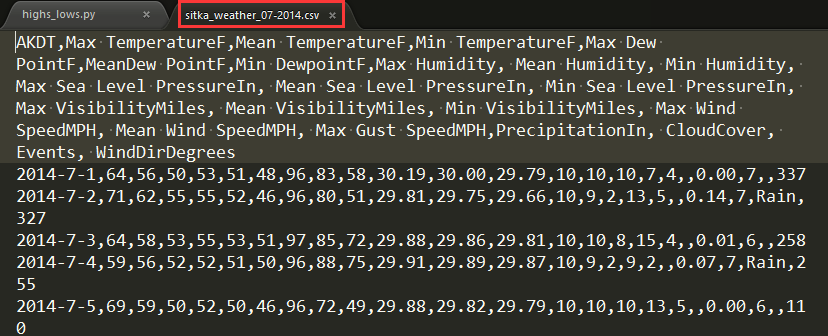
highs_lows.py文件信息
import csv
from datetime import datetime
from matplotlib import pyplot as plt
import matplotlib as mpl
# 解决中文乱码问题
mpl.rcParams['font.sans-serif']=['SimHei']
mpl.rcParams['axes.unicode_minus']=False
# Get dates, high, and low temperatures from
file.
filename = 'death_valley_2014.csv'
with open(filename) as f:
reader = csv.reader(f)
header_row = next(reader)
# print(header_row)
# for index,column_header in enumerate(header_row):
# print(index,column_header)
dates, highs,lows = [],[], []
for row in reader:
try:
current_date = datetime.strptime(row[0], "%Y-%m-%d")
high = int(row[1])
low = int(row[3])
except ValueError: # 处理
print(current_date, 'missing data')
else:
dates.append(current_date)
highs.append(high)
lows.append(low)
# 汇制数据图形
fig = plt.figure(dpi=120,figsize=(10,6))
plt.plot(dates,highs,c='red',alpha=0.5)# alpha指定透明度
plt.plot(dates,lows,c='blue',alpha=0.5)
plt.fill_between(dates,highs,lows,facecolor='orange',
alpha=0.1)#接收一个x值系列和y值系列,给图表区域着色
#设置图形格式
plt.title('2014年加利福尼亚死亡谷日气温最高最低图',
fontsize=24)
plt.xlabel('日(D)',fontsize=16)
fig.autofmt_xdate() # 绘制斜体日期标签
plt.ylabel('温度(F)',fontsize=16)
plt.tick_params(axis='both',which='major',labelsize=16)
# plt.axis([0,31,54,72]) # 自定义数轴起始刻度
plt.savefig('highs_lows.png',bbox_inches='tight')
plt.show() |
6.3 生成结果
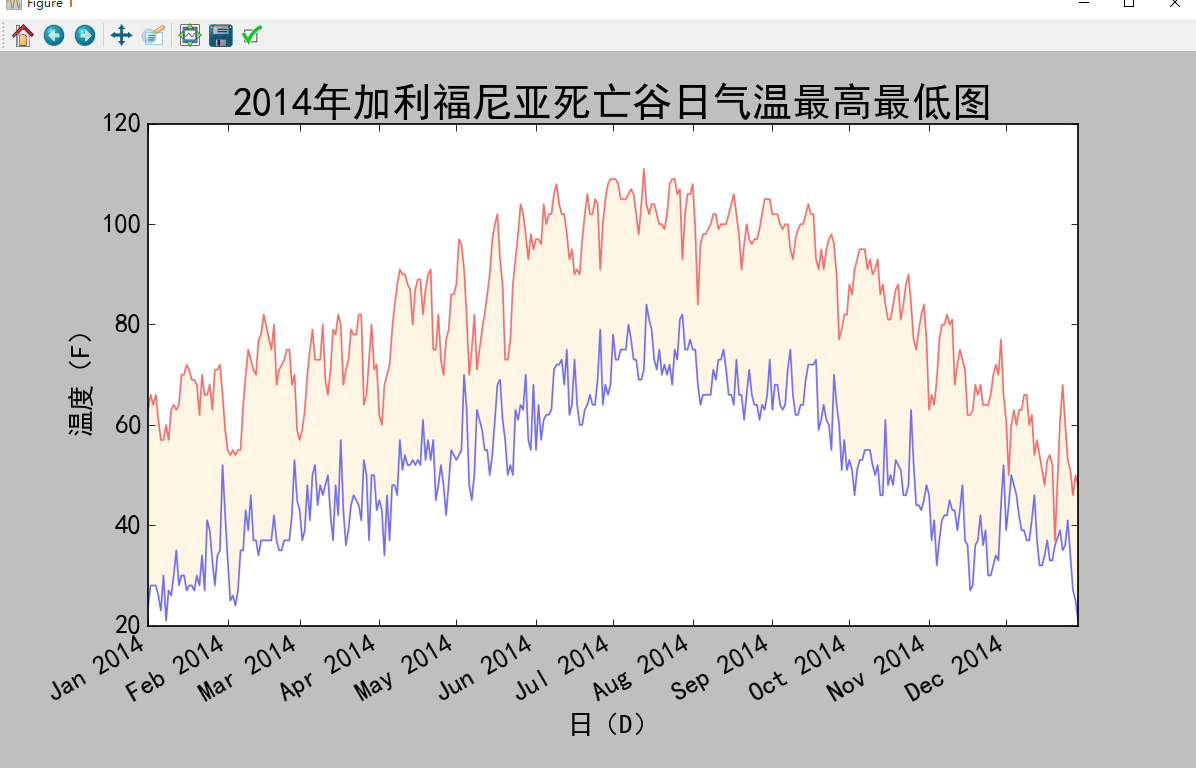
7 制作世界人口地图:JSON格式
7.1 需求描述
下载json格式的人口数据,并使用json模块来处理。
7.2 源码
json数据population_data.json部分信息
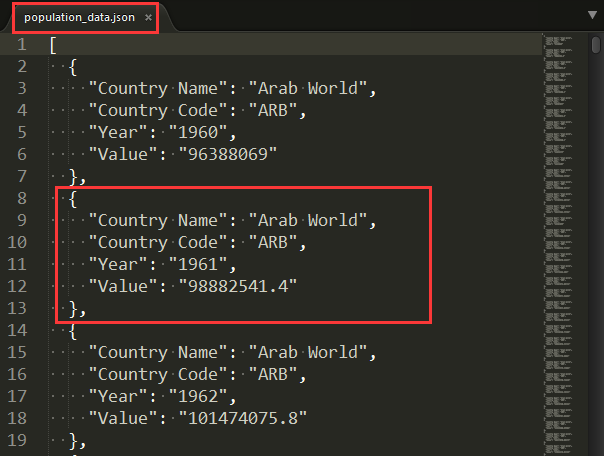
countries.py
from pygal.maps.world
import COUNTRIES
for country_code in sorted(COUNTRIES.keys()):
print(country_code, COUNTRIES[country_code]) |
countries_codes.py
from pygal.maps.world
import COUNTRIES
def get_country_code(country_name):
"""Return
the Pygal 2-digit country code for the given country."""
for code, name in COUNTRIES.items():
if name == country_name:
return code
# If the country wasn't found, return None.
return
print(get_country_code('Thailand'))
# print(get_country_code('Andorra')) |
americas.py
import pygal
wm =pygal.maps.world.World()
wm.title = 'North, Central, and South America'
wm.add('North America', ['ca', 'mx', 'us'])
wm.add('Central America', ['bz', 'cr', 'gt',
'hn', 'ni', 'pa', 'sv'])
wm.add('South America', ['ar', 'bo', 'br', 'cl',
'co', 'ec', 'gf',
'gy', 'pe', 'py', 'sr', 'uy', 've'])
wm.add('Asia', ['cn', 'jp', 'th'])
wm.render_to_file('americas.svg') |
world_population.py
#conding = utf-8
import json
from matplotlib import pyplot as plt
import matplotlib as mpl
from country_codes import get_country_code
import pygal
from pygal.style import RotateStyle
from pygal.style import LightColorizedStyle
# 解决中文乱码问题
mpl.rcParams['font.sans-serif']=['SimHei']
mpl.rcParams['axes.unicode_minus']=False
# 加载json数据
filename='population_data.json'
with open(filename) as f:
pop_data = json.load(f)
# print(pop_data[1])
# 创建一个包含人口的字典
cc_populations={}
# cc1_populations={}
# 打印每个国家2010年的人口数量
for pop_dict in pop_data:
if pop_dict['Year'] == '2010':
country_name = pop_dict['Country Name']
population = int(float(pop_dict['Value'])) #
字符串数值转化为整数
# print(country_name + ":" + str(population))
code = get_country_code(country_name)
if code:
cc_populations[code] = population
# elif pop_dict['Year'] == '2009':
# country_name = pop_dict['Country Name']
# population = int(float(pop_dict['Value']))
# 字符串数值转化为整数
# # print(country_name + ":" + str(population))
# code = get_country_code(country_name)
# if code:
# cc1_populations[code] = population
cc_pops_1,cc_pops_2,cc_pops_3={},{},{}
for cc,pop in cc_populations.items():
if pop <10000000:
cc_pops_1[cc]=pop
elif pop<1000000000:
cc_pops_2[cc]=pop
else:
cc_pops_3[cc]=pop
# print(len(cc_pops_1),len(cc_pops_2),len(cc_pops_3))
wm_style = RotateStyle('#336699',base_style=LightColorizedStyle)
wm =pygal.maps.world.World(style=wm_style)
wm.title = '2010年世界各国人口统计图'
wm.add('0-10m', cc_pops_1)
wm.add('10m-1bm',cc_pops_2)
wm.add('>1bm',cc_pops_3)
# wm.add('2009', cc1_populations)
wm.render_to_file('world_populations.svg') |
7.3 生成结果
countries.py
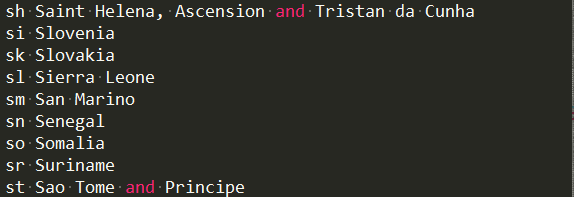
world_population.py
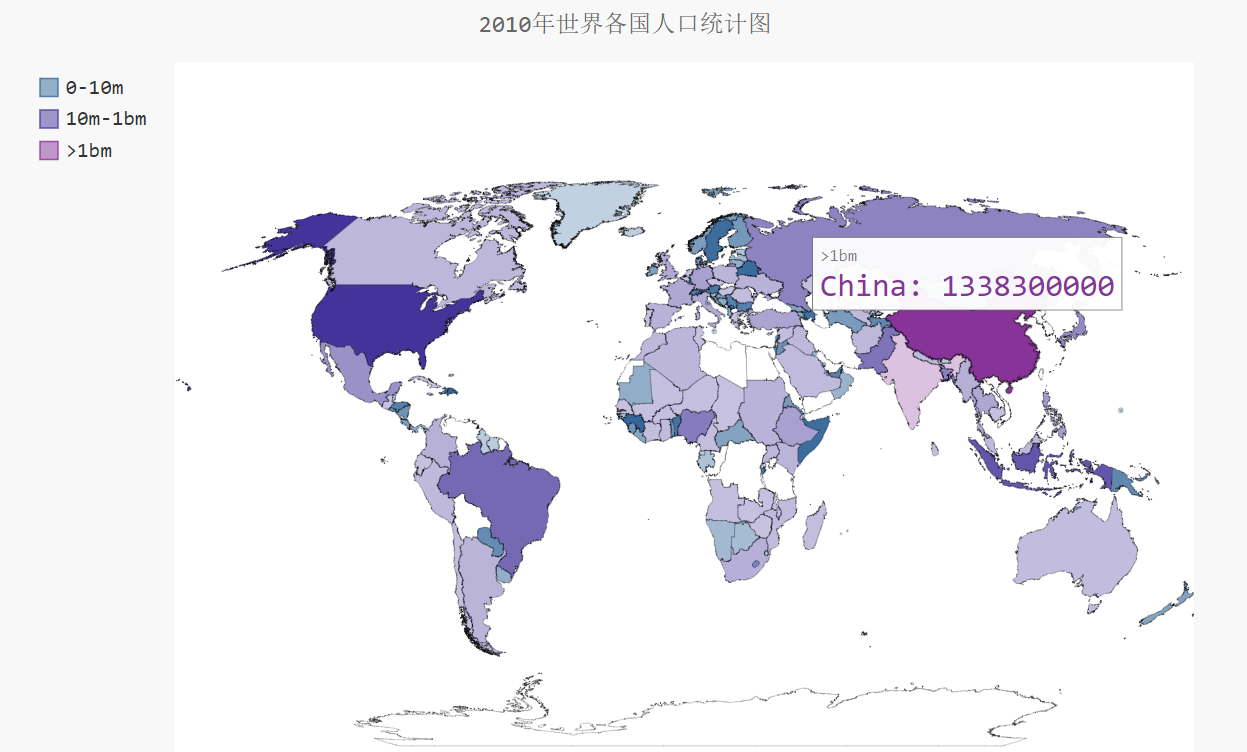
8 Pygal可视化github仓库
8.1 需求描述
调用web API对GitHub数据仓库进行可视化展示:https://api.github.com/search/repositories?q=language:python&sort=stars
8.2 源码
python_repos.py
# coding=utf-8
import requests
import pygal
from pygal.style import LightColorizedStyle as
LCS, LightenStyle as LS
# Make an API call, and store the response.
url = 'https://api.github.com/search/repositories?q=language:python&sort=stars'
r = requests.get(url)
print("Status code:", r.status_code)
# 查看请求是否成功,200表示成功
response_dict = r.json()
# print(response_dict.keys())
print("Total repositories:", response_dict['total_count'])
# Explore information about the repositories.
repo_dicts = response_dict['items']
print("Repositories returned:",len(repo_dicts))
# 查看项目信息
# repo_dict =repo_dicts[0]
# print('\n\neach repository:')
# for repo_dict in repo_dicts:
# print("\nName:",repo_dict['name'])
# print("Owner:",repo_dict['owner']['login'])
# print("Stars:",repo_dict['stargazers_count'])
# print("Repository:",repo_dict['html_url'])
# print("Description:",repo_dict['description'])
# 查看每个项目的键
# print('\nKeys:',len(repo_dict))
# for key in sorted(repo_dict.keys()):
# print(key)
names, plot_dicts = [], []
for repo_dict in repo_dicts:
names.append(repo_dict['name'])
plot_dicts.append(repo_dict['stargazers_count'])
# 可视化
my_style = LS('#333366', base_style=LCS)
my_config = pygal.Config() # Pygal类Config实例化
my_config.x_label_rotation = 45 # x轴标签旋转45度
my_config.show_legend = False # show_legend隐藏图例
my_config.title_font_size = 24 # 设置图标标题主标签副标签的字体大小
my_config.label_font_size = 14
my_config.major_label_font_size = 18
my_config.truncate_label = 15 # 较长的项目名称缩短15字符
my_config.show_y_guides = False # 隐藏图表中的水平线
my_config.width = 1000 # 自定义图表的宽度
chart = pygal.Bar(my_config, style=my_style)
chart.title = 'Most-Starred Python Projects
on GitHub'
chart.x_labels = names
chart.add('', plot_dicts)
chart.render_to_file('python_repos.svg') |
8.3 生成结果
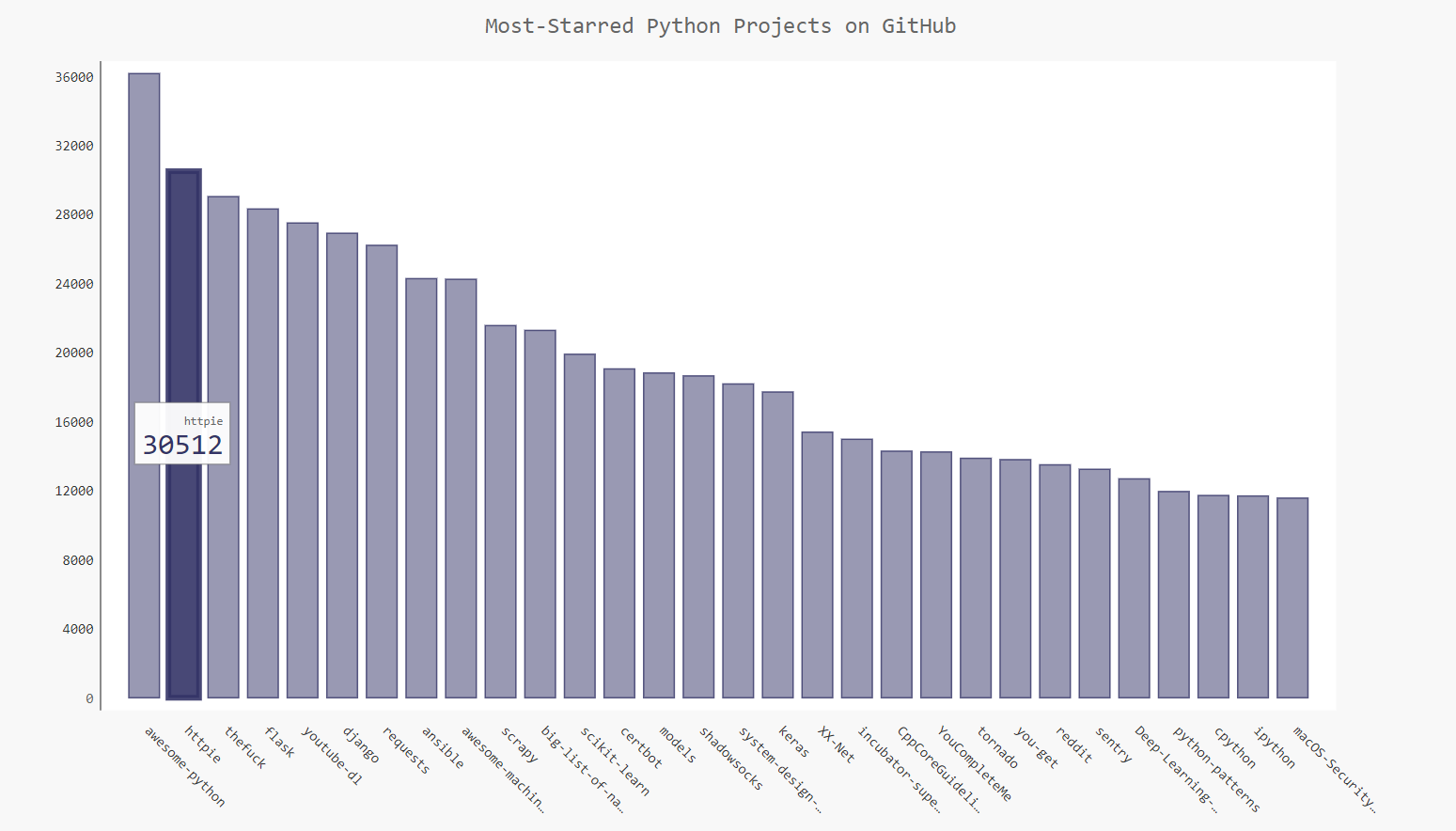
9 参考文献
1 matplotlib官网
2 天气数据官网
3 实验数据下载
4 google charts
5 Plotly
6 Jpgraph |